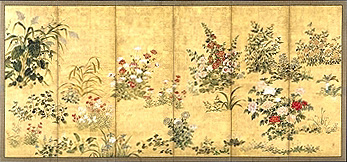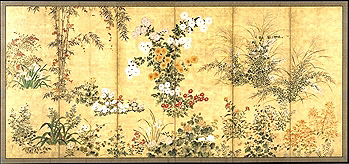

![]()
Sotatsu School Screens
Attributed to Sotatsu School
Flowers and Grasses of the Four Seasons
Edo period, c. 1620-1650
Pair of six-panel folding screens; color and ink on gold leaf on paper
Mr. and Mrs. John D. Rockefeller 3rd Acquisition Fund
These Rinpa screens were made for aristocratic patrons. They stand in constrast to the Four Seasons screens in the previous section, made by the Kano school for patrons of the warrior class. The pattern of flowers spread over a gold surface was typical of the yamato-e aesthetic favored by the nobility. The passage of the year is symbolized by the variety of plants that bloom in different seasons. Painted without outlines, this style is characterized as "boneless." Its delicacy, preciousness, and effeminacy is identified with the over-refinement of its patrons, while the vigor, monochromatic discipline, sharp observation, and virile forms of the Kano school are a testament to the vitality of the rising warrior class.
In larger rooms, screens could be displayed side by side, such as in this example. The accordion arrangement of the panels also lends the plant and floral motifs a vibrant sense of three-dimensionality.

